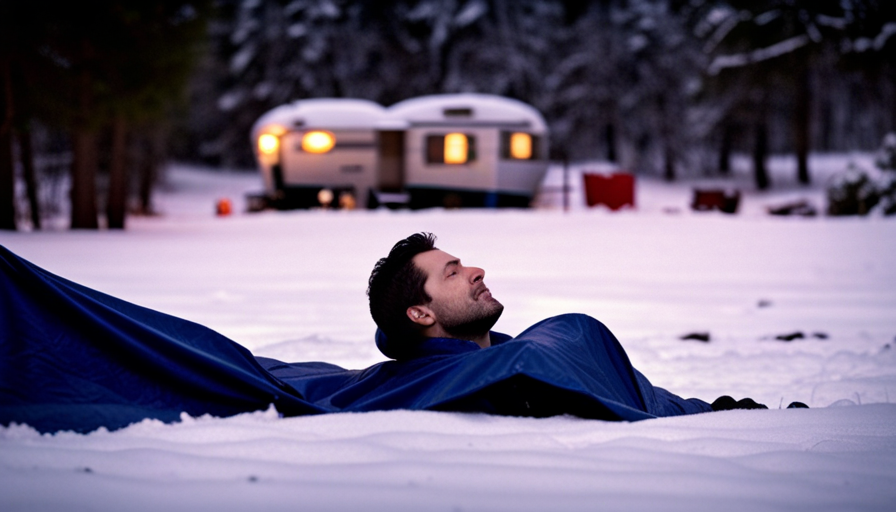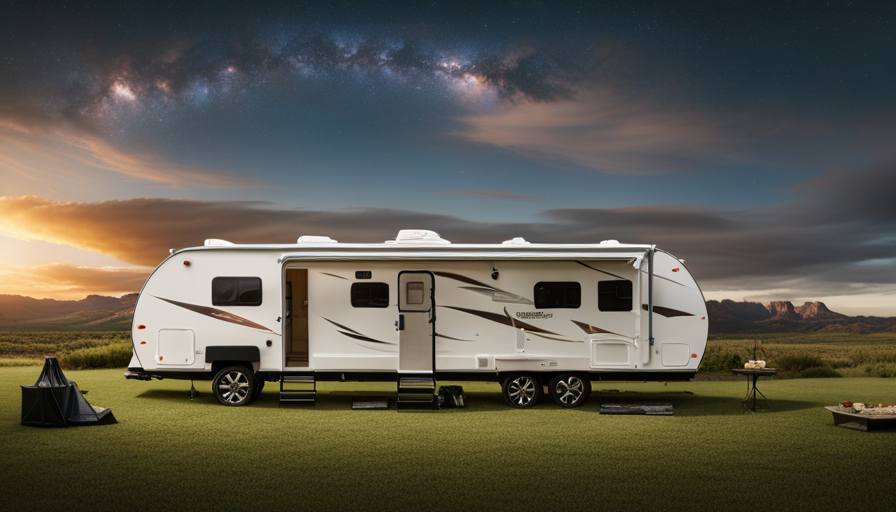Envision yourself navigating a meandering path, enveloped by breathtaking scenery, accompanied by the soothing splash of water against your kayak. As someone deeply enthusiastic about camping and kayaking, I grasp the charm of bringing together these outdoor pursuits. Yet, the challenge of transporting kayaks alongside a camper can be overwhelming without proper guidance. This is why I aim to walk you through each phase of the process, ensuring you tackle this task with ease.
In this article, I will share practical tips and techniques to ensure a safe and hassle-free journey. From assessing your camper’s capacity to properly securing your kayaks, I’ve got you covered. We’ll also discuss the importance of weight distribution, additional safety precautions, and planning kayak-friendly stops along your route.
So, whether you’re a seasoned camper or a beginner, get ready to embark on unforgettable kayak-camping adventures with confidence and ease.
Key Takeaways
- Assess camper’s weight limits before transporting kayaks.
- Invest in a reliable kayak rack or trailer for secure transportation.
- Use strong and reliable straps specifically designed for kayak transportation to secure kayaks.
- Distribute weight properly for balanced towing.
Assess Your Camper’s Capacity and Kayak Size
Now, let’s take a moment to assess how much your camper can handle and what size kayaks you can safely haul. It’s important to know your camper’s weight limits before attempting to transport kayaks. Check the manufacturer’s specifications or consult your camper’s manual for this information. Exceeding the weight limits can cause serious damage to your camper and compromise your safety on the road.
Once you know your camper’s weight limits, you can determine the size of kayaks you can safely haul. Consider the length and width of your kayaks and compare them to the available storage options in your camper. Some campers have built-in kayak storage compartments, while others may require you to use external racks or trailers. These storage options should be able to accommodate the size and weight of your kayaks securely.
Investing in a reliable kayak rack or trailer is essential for safely hauling your kayaks with a camper. This will provide a secure and stable way to transport your kayaks without putting excessive strain on your camper. Look for racks or trailers specifically designed for kayaks, as they’ll have the necessary features to ensure a safe and hassle-free journey.
Now that you’ve assessed your camper’s capacity and determined the size of kayaks you can safely haul, it’s time to move on to the next step – investing in a reliable kayak rack or trailer.
Invest in a Reliable Kayak Rack or Trailer
First, you’ll want to outfit your adventure rig with a sturdy and dependable rack or trailer, like a trusted wingman ready to safeguard your precious watercraft.
There are several types of kayak racks or trailers available to choose from, each with their own advantages and considerations. Here are five options to consider:
-
Roof racks: These are the most common and versatile option, allowing you to carry your kayak on top of your camper. Make sure to choose one that’s compatible with your vehicle and can securely hold your kayak.
-
Hitch-mounted racks: These racks attach to the back of your camper’s hitch receiver and are convenient for loading and unloading your kayak. Ensure that your hitch receiver has the appropriate weight capacity.
-
Bed racks: If you have a truck camper, a bed rack is a great option. It allows you to transport your kayak securely in the bed of your truck.
-
Trailers: Kayak trailers are specifically designed to haul multiple kayaks at once. They offer ease of loading and unloading, and some even come with additional storage options.
-
Inflatable racks: If you’re short on storage space, inflatable racks can be a practical solution. They’re lightweight, easy to install, and can be deflated when not in use.
When choosing a kayak rack or trailer, consider factors such as weight capacity, ease of installation, durability, and compatibility with your camper. Once you have your rack or trailer in place, you’ll be ready to securely strap down your kayaks for a worry-free journey to your next paddling destination.
Securely Strap Down Your Kayaks
To ensure a smooth and worry-free journey, you’ll want to tightly secure your kayaks, making sure they’re snugly fastened and ready for the open road. Properly strapping down your kayaks is crucial for safe and efficient transportation.
When it comes to strapping techniques, there are a few key points to keep in mind. Firstly, you’ll need strong and reliable straps specifically designed for kayak transportation. Ratchet straps are highly recommended as they provide excellent tension and ensure that your kayaks stay in place.
Start by placing the kayaks on the rack or trailer, making sure they’re centered and evenly distributed. Then, wrap the straps around the kayaks, passing them through the rack or trailer’s tie-down loops. Tighten the straps using the ratchet mechanism until the kayaks are securely fastened. Double-check the tightness and adjust if necessary.
Additionally, it’s important to tie off any loose ends of the straps to prevent them from flapping in the wind. This not only helps to reduce noise but also ensures that the straps stay in place throughout your journey.
Once you’ve securely strapped down your kayaks, you’re ready to hit the road!
Moving forward, let’s discuss the next important step: using protective padding and tie-downs. This’ll provide an extra layer of protection and stability for your kayaks during transportation.
Use Protective Padding and Tie-Downs
Ensure a worry-free journey by adding an extra layer of protection and stability to your kayaks with protective padding and tie-downs. It’s important to invest in quality protective gear to safeguard your kayaks from any damage during transportation.
The padding acts as a cushion, preventing scratches and dents caused by friction or impact. Additionally, tie-downs are essential for securing your kayaks firmly in place, minimizing the risk of them shifting or falling off during the trip.
Here are three important things to keep in mind when using protective padding and tie-downs:
-
Choose the right padding: Look for foam or rubber padding specifically designed for kayaks. This will provide a soft and durable layer of protection against any potential damage.
-
Use proper tie-down techniques: Make sure to use strong and reliable straps to secure your kayaks to the camper. Wrap the straps around the kayaks and camper, tightening them securely so that the kayaks remain stable throughout the journey.
-
Double-check everything: Before hitting the road, double-check that all straps are properly tightened and that the padding is securely in place. This’ll give you peace of mind knowing that your kayaks are well-protected and won’t budge during the trip.
By following these tips, you can ensure that your kayaks are well-protected and securely fastened for a safe and enjoyable journey. Distributing weight properly for balanced towing is the next crucial step in ensuring a smooth ride with your kayaks in tow.
Distribute Weight Properly for Balanced Towing
For a smooth and balanced towing experience, you’ll want to make sure you distribute the weight of your gear properly, avoiding any wobbles or instability. Proper weight distribution is crucial for towing safety, especially when hauling kayaks with a camper.
Failing to distribute the weight evenly can lead to a host of problems, such as reduced stability, increased swaying, and potential damage to your equipment.
To achieve proper weight distribution, start by placing the kayaks as close to the camper’s center as possible. This helps maintain balance and prevents the trailer from fishtailing. Additionally, use a kayak rack or carrier that evenly distributes the weight across the camper’s roof. This ensures that the weight is not concentrated in one area, reducing the risk of sway.
When securing the kayaks, use high-quality tie-down straps and ensure they’re tightened properly. This’ll keep the kayaks stable during travel and minimize any movement that could throw off the weight distribution. It’s also a good idea to use additional padding between the kayaks and the camper to prevent any scratches or damage.
Remember, distributing the weight properly is just one aspect of towing safety precautions. Once the weight is distributed, it’s important to check and double-check all connections to ensure they’re secure before hitting the road. By following these steps, you can confidently haul your kayaks with a camper, knowing that you’ve taken the necessary precautions for a safe and enjoyable journey.
Check and Double-Check All Connections
Now that you’ve properly distributed the weight of your kayaks for balanced towing, it’s time to move on to the next crucial step: checking and double-checking all connections. Ensuring that your kayaks are securely attached to your camper is essential for a safe and worry-free journey.
To start, create a checklist for proper kayak connections. This checklist should include items such as inspecting the kayak straps for any signs of wear or damage, making sure the straps are tight and snug, and verifying that the kayak racks or mounts are securely fastened to your camper. It’s also important to check that all kayak accessories, like paddles and life jackets, are securely stored and won’t come loose during transit.
When hauling kayaks with a camper, there are common mistakes to avoid. One common error is not properly tightening the straps, which can result in the kayaks shifting or even falling off during travel. Another mistake is neglecting to secure the kayak racks or mounts properly, leading to instability and potential damage.
By diligently following your checklist and avoiding these common mistakes, you can ensure that your kayak connections are reliable and secure.
In the next section, we’ll discuss how to utilize additional safety precautions to further enhance your kayaking adventure with a camper.
Utilize Additional Safety Precautions
To make your kayaking adventure with a camper even more enjoyable and worry-free, there are some extra safety precautions you can take. In addition to checking and double-checking all connections, it’s important to utilize additional safety measures to ensure a smooth and secure journey. Let’s take a look at some practical tips to minimize potential risks:
| Safety Precaution | Description | Why it’s Important |
|---|---|---|
| Secure Kayaks Properly | Use sturdy kayak straps to secure your kayaks to the camper. Make sure they are tightly fastened and double check them throughout your trip. | This prevents your kayaks from shifting or falling off during transit, reducing the risk of accidents or damage. |
| Balance the Weight | Distribute the weight of your kayaks evenly on the camper to maintain balance and stability on the road. | Proper weight distribution prevents swaying or tipping, ensuring a safer and smoother journey. |
| Use Protective Covers | Cover your kayaks with protective covers to shield them from road debris, weather elements, and potential scratches. | This protects your kayaks from potential damage, preserving their quality and prolonging their lifespan. |
By implementing these additional safety measures, you can greatly reduce the chances of any mishaps during your kayaking adventure with a camper. Now that your kayaks are securely loaded, it’s time to plan your route with kayak-friendly stops to make the most of your journey without any hassle.
Plan Your Route with Kayak-Friendly Stops
As you embark on your kayaking adventure with a camper, it’s time to map out a route that includes stops specifically designed for kayakers like yourself.
One of the first things to consider is finding kayak-friendly campsites along your route. These campsites often offer amenities such as kayak storage solutions, so you can safely keep your kayaks while you explore the surroundings. Look for campsites that have designated kayak racks or secure storage areas where you can lock up your kayaks when you’re not using them. This will give you peace of mind knowing that your kayaks are safe and protected.
Additionally, consider planning your route to include stops at places that are known for their kayak-friendly facilities. Look for marinas or boat ramps that provide easy access to the water, making it convenient for you to launch your kayaks. Some places even offer kayak rentals and guided tours, giving you the opportunity to explore new waters and meet fellow kayaking enthusiasts.
With your route planned and your kayak-friendly stops mapped out, it’s time to move on to the next step: practicing loading and unloading techniques. By mastering these techniques, you’ll be able to easily and safely transport your kayaks with your camper.
Practice Loading and Unloading Techniques
Get ready to perfect your skills in loading and unloading your trusty kayaks onto your camper, making it a breeze to hit the water whenever you desire.
Here are some essential loading and unloading techniques to ensure a smooth process:
-
Loading Techniques:
- Use kayak racks: Invest in a sturdy and reliable kayak rack that can securely hold your kayaks on top of your camper. This will prevent any damage to your kayaks during transport.
- Distribute the weight evenly: When loading your kayaks onto the rack, make sure to distribute the weight evenly on both sides of the camper. This will help maintain stability while driving.
- Secure with straps: Once your kayaks are in place, use strong and durable straps to secure them tightly to the rack. Double-check the straps to ensure they’re tight and won’t come loose during the journey.
- Protect your kayaks: Consider using kayak covers or protective padding to prevent any scratches or damage during the loading process.
-
Unloading Techniques:
- Take it slow: When unloading your kayaks, take your time and be cautious. Slowly lower them down from the rack, ensuring a controlled and safe descent.
- Use assistance if needed: If your kayaks are heavy or you need help, ask a friend or family member to assist you in unloading them. This’ll prevent any accidents or injuries.
- Store properly: Once unloaded, store your kayaks in a safe and secure location, such as a designated kayak storage area or inside your camper.
With these loading and unloading techniques mastered, you’re now ready to embark on your kayak-camping adventures!
Enjoy Your Kayak-Camping Adventures!
Embarking on kayak-camping adventures is an exhilarating way to immerse myself in nature and experience the thrill of exploring the waterways. Not only do I get to camp in picturesque locations, but I also have the freedom to paddle and discover new camping destinations. To make the most of my kayak-camping trips, I have learned some valuable tips for storing my kayaks while camping.
Firstly, it’s essential to choose a secure and convenient storage method for my kayaks. One option is to use kayak cradles or racks installed on the roof of my camper. This helps protect the kayaks from damage during transportation and keeps them out of the way when setting up camp. Another option is to store the kayaks inside the camper, either on the floor or secured to the walls using straps or bungee cords.
To help visualize these storage options, here’s a handy table:
| Storage Method | Advantages | Disadvantages |
|---|---|---|
| Roof Cradles | Easy access, protects kayaks | May require additional installation |
| Inside Camper | Protection from elements, space-saving | Limited space, potential damage to interior |
Regardless of the storage method, it’s crucial to secure the kayaks properly to prevent any unwanted movement while driving. I use strong tie-down straps and regularly check their tightness during my journey.
By following these tips for storing kayaks while camping, I can fully enjoy my kayak-camping adventures and explore new camping destinations with ease and peace of mind.
Frequently Asked Questions
How do I assess my camper’s capacity and determine the appropriate kayak size to haul?
To assess my camper’s capacity and determine the appropriate kayak size to haul, I need to consider a few factors.
First, I’ll check the weight capacity of my camper’s roof rack or towing capacity if I plan to use a trailer.
Then, I’ll measure the length and width of the available space to ensure it fits the kayak comfortably.
Additionally, I’ll consider the weight distribution and stability while driving.
It’s crucial to choose a kayak that aligns with these specifications for a safe and hassle-free journey.
What are some reliable kayak rack or trailer options that I can invest in?
Some reliable kayak rack options include the Thule Hullavator Pro, Yakima JayLow, and Malone Downloader. These racks are designed to securely transport kayaks on top of your camper.
If you prefer a trailer, the best kayak trailers include the Malone MicroSport Trailer and the Yakima RackandRoll Trailer. These trailers are sturdy, easy to use, and can accommodate multiple kayaks.
Investing in a reliable rack or trailer will ensure a safe and hassle-free kayaking adventure with your camper.
How do I securely strap down my kayaks to ensure they stay in place during travel?
To ensure my kayaks stay put during travel, I first assess the weight capacity of my camper’s racks or trailer. Then, I secure the kayaks with durable straps, making sure they’re tightly fastened to prevent any shifting.
It’s crucial to distribute the weight evenly and avoid overloading. I double-check the straps periodically during the journey to ensure they remain tight. By taking these precautions, I can confidently hit the road knowing my kayaks will stay securely in place.
What type of protective padding and tie-downs should I use to prevent damage to my kayaks?
To prevent damage to your kayaks during travel, there are a few protective padding options and tie-down options you can consider.
For padding, foam blocks or kayak cradles can provide cushioning and support.
When it comes to tie-downs, use strong and durable straps with cam buckles or ratchet systems to secure your kayaks tightly. Additionally, consider using bow and stern lines for extra stability.
These options will help ensure your kayaks stay in place and protected during your camper trip.
How should I distribute the weight of the kayaks properly for balanced towing and safe driving?
To ensure balanced towing and safe driving, it’s important to distribute the weight of the kayaks properly. Start by assessing your towing capacity to determine how much weight your camper can handle. Then, evenly distribute the weight of the kayaks on your camper. Avoid placing all the weight on one side as this can lead to instability. Remember the adage "even distribution, smooth transmission" to create a rhythm and flow while hauling your kayaks with a camper.
Can I Use the Same Truck Setup to Haul Both a Camper and Kayaks?
When it comes to hooking up a camper to a truck, using the same truck setup for hauling kayaks might not be ideal. While a truck with the right equipment can handle campers, carrying kayaks requires different racks and supports. It’s essential to consider weight distribution, secure fastening, and clearance for both activities to ensure a safe and efficient trip.
Conclusion
As I reflect on the process of hauling kayaks with a camper, I can’t help but see it as a metaphor for life’s journey. Just like securing our kayaks and distributing weight for balanced towing, we must also find balance in our own lives.
We need reliable tools and safety precautions to navigate the challenges that come our way. By planning our routes and practicing loading techniques, we can ensure smooth sailing through the ups and downs.
So, embrace the adventure, and may your kayak-camping journeys be filled with joy and fulfillment!










